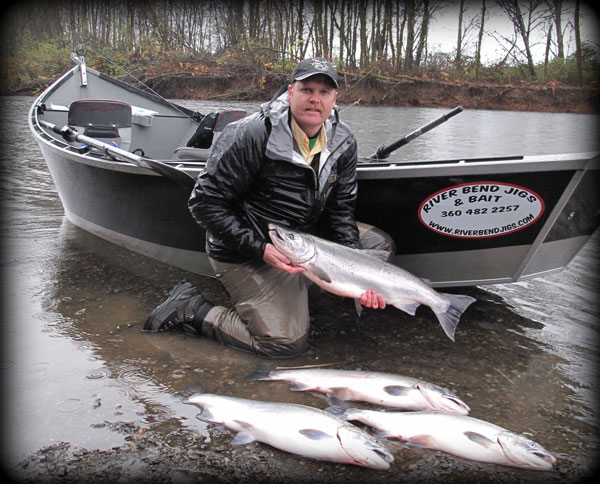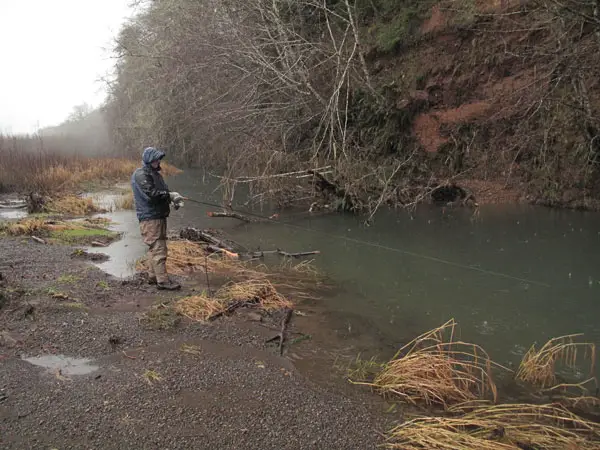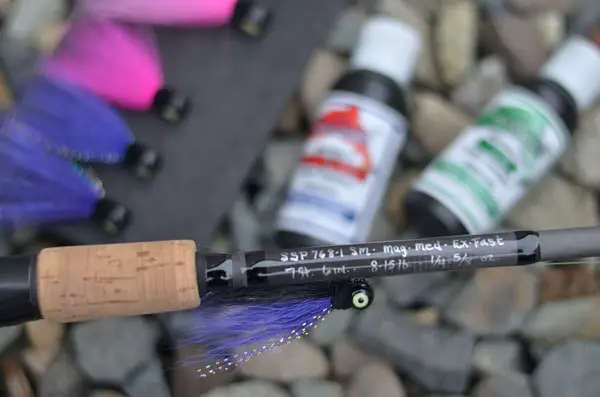Search
Latest Articles
Twitching Jigs for Fall Salmon
by Jason Brooks, October 12, 2014
Twitching jigs for fall salmon is pretty much a mainstay now but not too long ago the internet forums lit up with accusations of it nothing more than a justified way to snag fish. This was primarily because the people trying to twitch wouldn’t properly use the technique and when a big fish came in backwards some of them couldn’t keep from giving in to temptation and bonked it. It only took a handful of times for this to occur and then twitching was labeled as snagging. Luckily time has healed most of those wounds and it is becoming recognized for what it is, a great technique to catch fish. It is a fairly simple way to fish requiring very little gear but the technique itself can be hard to learn as it goes against what most fisherman are taught. Conventional fishing is to hold the rod as steady as possible waiting to feel the slightest bite but twitching means you are actively moving the rod and trying to feel the bite at the same time. For me this causes my brain to go into overload, “Was that a bite, a weed, the bottom? Dang I just missed a fish…”
In order to be successful at twitching jigs you do need the right gear. I often see guys trying to use their standard drift rods or worse yet long, limber float rods as this is either all they know to use for salmon or they try and twitch jigs as an afterthought when other techniques aren’t working. The rod, in my opinion, is the most important part of this technique even more so than the jig. To properly twitch you will be flicking your wrist constantly.
A few years ago I used my “go to” rod, an 8 ½ foot spinning rod rated for 10-20# line with a moderate action. A great drift fishing rod or one I could throw spinners or toss spoons with basically a great “all around” rod. However my forearm and wrist would be killing me by the end of the day after twitching jigs. Ted Schuman, a good friend of mine, spends a lot of time on the water each fall and twitches jigs a lot. It was this day that he handed me one of his jig twitching rods. First I noticed it was a bit shorter at 7 ½ feet. It was rated for a lighter line and had fast action. This little spinning rod was more for trout than for salmon but he paired it with a sturdy 2500 series reel spooled with 30# braid.
Ted explained that the reason he used this rod is for balance keeping it heavier near the reel and lighter at the tip. This makes it easy to flick your wrist without tiring your forearm. One of the things I didn’t like about the rod was that it did make it a little harder to cast and sometimes casting a jig to tight spot between logs or near the shore where Coho like to hide means precise aim and the short rod wasn’t good for this. We talked throughout the day on what the perfect twitching rod would be, and finally agreed the length should stay short as the longer rods are too hard to balance but if the rod had a stiff middle section, where the “power” of the rod comes from casting would be easier. The tip of the rod would need to be extra fast action, as with a stiffer tip when you flick your wrist to twitch the jig this causes a slight slack time in your line which happens to be when the jig is on the drop and this is when the fish is striking the jig. During this slack time is when I miss most of my fish as it isn’t until you flick your wrist again do you feel the tension of the fish and then have to set the hook but your mind is already in the relax and flick mode so I often don’t set the hook when I should be and miss the bite. Ted’s theory of having an extra fast tip means that as the jig falls the rod stays “loaded”, a fly fishing term when the rod is bent and holding the line. This means the jig can free fall but you still maintain sensitivity by feeling the jig fall. When a fish grabs the jig you feel it immediately and can set the hook. Thanks to the stiff middle section of the rod the hook set is much easier than on the limber trout type rod and you can fight the fish much easier. Lastly, Ted added that the rod should have a fairly long handle. This allows you to use your entire forearm as you brace the handle against your arm as you fight the fish giving the 7 ½ foot rod the power and strength you need to fight a Chum or Chinook and not tire out your wrist.
This past spring Ted told me has been talking to Wayne and Diana Anderson of North Fork Custom Rods, and they came up with the “perfect” twitching rod. Ted stopped by my house in early September and brought me one of the rods. He knew I was going to float the Humptulips again that weekend and he wanted me to give the new rod a try. As I anchored in a deep hole my first two cast didn’t go as planned, as I had tried to use a ¼ oz. jig as the water was extremely low and clear which meant that a heavy jig would make too big of a splash and I had to keep the boat far away from the holding fish. Finally on my third cast I made it far enough into the deep hole and I began flicking my wrist to twitch the jig. Just as Ted said, even with a ¼ oz. jig I could feel it falling on the pause of my twitching and then I felt it, the resistance of a fish and set the hook. The small buck, around 7 pounds, fought hard and was fresh from the ocean but thanks to the power of the rod I brought it to the net quickly and kept it from going into the logs it was hiding in. It was a wild fish and as I unpinned the jig and slid the fish back to the deep hole I was impressed with this rod.
Other companies make rods that can be used for twitching but the one made by North Fork Customs Rods is specifically made for twitching jigs for salmon. It is extremely light, strong and sensitive but other rods that are similar in style work for twitching. If you are looking for a rod remember that balancing the weight of the rod to the rear is probably the most important to keep your wrist and forearm from becoming fatigued. A standard spinning reel spooled with braid completes the terminal gear. Personally I like to use #20 hi-viz braid as I want the strength of the line but also be able to break it off if I get my jig stuck in a log.
The jig is the second most important part of twitching, though some will say it is the most important, but if your arm is too sore and weak to cast then what good is a great jig. These are big fish we are after and the jig needs to be able to fall so your standard steelhead jigs that are fished under a bobber won’t work. As mentioned earlier I will use ¼ oz. jigs in low clear water but once fall rains start my tackle box is full of 3/8 oz. and some ½ oz. jigs. Colors of the jigs are what make them so debatable. My primary color is the black and purple. In most water color conditions this combination out produces all others for Coho. However, I learned a valuable lesson one day during a down pour. As the water turned from clear to mud brown I noticed a few other boats throwing bright chartreuse spinners. Years ago, when I was a firearm in the Air Force we drove bright chartreuse fire trucks on the flight line. We were told that after an extensive study (costly I am sure) it was determined that in foggy, low visibility days that the chartreuse color was the most visible. With that theory the fish were biting the bright spinners and I didn’t touch a fish with my black and purple jigs. Since then I always make sure to have other colors along.
My second “go to” jig color is the black and cerise as Coho, as well as Chums attack the bright cerise. You will also find black and chartreuse and a few hand tied custom jigs with a white head and cerise or chartreuse body. The reason why those ones are hand ties is because they aren’t made by what I consider the best twitching jig on the market, Mack’s Lure Rock Dancer.
The Rock Dancer 3/8 ounce jig uses a 2/0 heavy wire hook and a pancake lead head with a glow eye. First the hook needs to be fairly stout as a big fish will bend out light wire hooks and the Rock Dancer uses such a heavy and sharp hook. The pancake style lead head of this jig allows it to sink faster which is very important in twitching jigs as it is the falling of the jig that causes the fish to strike. When I have to upsize to a ½ ounce jig this is because I am fishing them in faster water but with the Rock Dancer’s pancake head I have been able to fish them in almost all water conditions. One last thing about the Rock Dancer jig is that it has a chenille collar. This collar holds scent really well. Most guys twitching jigs don’t think about applying scent as most will use a marabou jig and the oily scent destroys the action of the jig. Since the Rock Dancer is a bucktail jig it is extremely durable and the oily scent won’t ruin the action. The chenille collar allows me to soak the scent and as it seeps out the bucktail disperses it into a cloud and makes it much more effective. My favorite scents are from Northwest Bait and Scent with it being a local company and Guide Shane Magnuson continually testing and using the scents they are constantly improving them. Often times I will use garlic or their anise/crawfish scent. I have witnessed Coho chase down my jig only to turn away at the last second. Before the next cast I will add some scent and again watch the Coho follow the jig but once the fish is right up to it the fish attacks it. I believe it’s because the fish gets to the “bite or not” time in the strike and the scent hits the fish in the nose and it can’t resist.
The technique is the hardest part about twitching jigs but if you break it down to type of water then it can be a bit easier. There are three primary water conditions I fish which are: holding water such as deep holes or back sloughs, structure such as under logs or along deep grass, and moving water like seams where the fish travel.
Holding water is slow or stagnant water where fish are resting. They often group up and want to lie on the bottom of the river. This is where twitching got such a bad reputation as it is very easy to foul hook a fish especially with a jig. The key here is to know that the fish on the bottom are at total rest, more than likely not willing to bite so you don’t want your jig to hit the bottom. The fish just above them, often seen circling constantly, are trying to find a place to lay on the bottom and therefore aggressive as they don’t want anything to get in their way, at least this is what I have found after watching fish in these holding areas for the past several years. When you fish the holding water you want to let the jig sink down to the circling fish and then flick your wrist causing the jig to twitch up. As you let the rod tip fall the jig free falls. It is when the jig is falling that the fish will bite it. My theory is that a fish can only see up or out, but not down. As the jig is twitched upwards the fish can see it but as the jig starts to fall the fish starts to lose sight of it. It is this impulse of the fish, not knowing what to do as the jig is about to leave their site that causes them to bite it. In holding water you want fairly long “twitches” so that the jig has time to free fall in the slow water where the fish have time to watch it and then the impulse to strike will take over. When I twitch in holding water I flick my rod tip about a foot to a foot and a half.
Structure water is where fish are hiding from predators. This is done naturally but the fish are a bit spooked as they know that they are exposed since this is often shallower water. Unlike the holding water where the fish use the depth as security the structure water is often only a foot to a few feet deep such as in a log jam or tall grass along the shoreline. If it is a rainy day and the water is on the rise we know that the softer water is right along the shoreline making it easier for the fish to travel and rest. Coho especially will often sit next to tall grass much like a bass will. Cast to the edge of the grass and begin to twitch. I have caught more fish on my first “twitch” along grassy shorelines as often when the jig hits the water it’s right in front of the fish and it instinctively strikes. For log jams I fish right along the edge of the logs. If there is current there I will either cast up stream of the logs and allow my jig to drift under the structure or I will bounce the jig off of the log, allowing it to fall right next to the log. I then twitch the rod in short flicks and reel when I get slack line or need to move the jig. This is where the hi-viz line really helps as you can see where you jig is, especially if you cast upstream and let it drift under the structure.
Moving water such as a seam is not where you find most people twitching jigs as they don’t think it will work. Instead this is where most will use spinners and spoons. I use a technique I call “drift twitching” which means I will cast out, slightly upstream, which allows my jig to sink. Once I feel like it is in the zone of where the fish are I begin twitching it with short flicks of the wrist about 6 inches in height. Instead of reeling in the line I just continue to twitch the jig allowing it to drift along the seam. The twitching keeps it off of the bottom and the “dancing” of the jig causes the fish to strike. This is one of my favorite ways to twitch jigs for salmon.
Last November I showed the drift twitching technique to a couple of my fishing buddies while on the Satsop and we ended up boating more than 50 fish that day because we knew how to fish jigs in virtually all types of water. We did float eggs once in a while but almost all of the fish came from twitching jigs. At the end of this trip there was little for me to clean up as we mostly just used one technique. This made for a pleasant day and a lot more room in the drift boat without the need to have all those rods along or garbage left over from bait containers.


